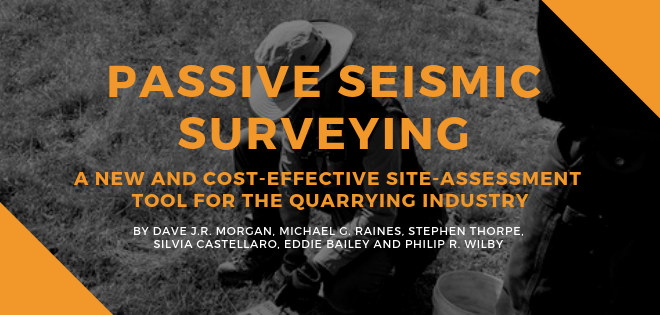News & Articles
Passive Seismic Surveying with Tromino
|
Passive Seismic for Quarries The application of passive seismic measurements (VS/VP) is gaining in popularity due to the availability of small, portable all-in-one seismographs. Without requiring the additional deployment of cables and multiple geophones, this technique can be used to study soil stiffness and depth to bedrock. A very straight-forward application is its use in the quarrying industry to map possible extensions of existing workings. A very nice article about this was published in Quarry Management and we provide it to you here as a download. PASSIVE SEISMIC SURVEYING > |
.png) |

Good quarry design and efficient operation depend upon a ground model that reliably defines the quality, volume and spatial distribution of resource and waste. Most ground models are based on boreholes, sometimes with additional 2D or 3D control provided by ‘traditional’ geophysical surveys such as microgravity, resistivity and active seismic. However, for logistical and economic reasons, these may not always be practical options for site investigations. This article showcases ‘passive’ seismic survey as a rapid and versatile alternative means of imaging the subsurface, using the Phase 2 extension area of Aggregate Industries UK Ltd’s Bardon Hill Quarry in Charnwood Forest, Leicestershire, as an example. The technique can be used to generate results comparable to traditional high-resolution seismic refraction surveys, but has the distinct advantage over these (and other geophysical techniques) of not requiring extraneous cables, power supplies or artificial seismic sources. Hence, it can be easily deployed by a single operator even at sites that are sensitive or difficult to access, rendering it an especially cost-effective option for the quarrying industry.
What is passive seismic surveying?
Background seismic noise – both natural and man-made – has traditionally been regarded as a nuisance by geophysicists, but it is now known to contain useful information about the physical character of the subsurface. Passive seismic surveys harvest this noise in order to generate vertical profiles (2D slices) through the ground, with variations in impedance contrast (velocity x density) shown as a colour ramp (fig. 1). The technique can be applied to any setting where softer layers overlie harder substrates – a very common geological situation – and, depending on the nature of the ambient seismic noise and the physical properties of the ground, can resolve features at the very near surface all the way down to several hundred metres depth.
DOWNLOAD THE FULL ARTICLE HERE >